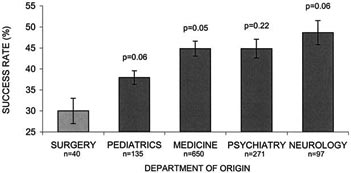The White Rhinoceros
ACADEMIC SURGERY AS AN ENDANGERED SPECIES

Matthew Howard
|
The 2009 Wilfred G. Bigelow
Lecture, given by Matthew
Howard III, Professor and Head of
the Department of Neurosurgery,
Iowa State University examined
the current status and challenges
facing Academic Surgery. Dr.
Howard compared the contemporary
surgeon-scientist to the
white rhinoceros, one of the first
creatures to capture the public imagination as an endangered
species. He highlighted data by Rangel et al demonstrating
that compared to their colleagues, surgeons
simply are not applying for NIH grants and when they
do apply, they are not getting funded Fig 1. Whether it
be the white rhino or the surgeon scientist, Dr. Howard
argued that we need to gain knowledge of the animal
and its environment, determine the causes of impending
extinction and formulate a rescue plan.
The challenges facing surgeon scientists today include
the apparent cognitive dissonance between surgical
practice and scientific surgical investigation. There is a
fundamental difference between the mental discipline
necessary to run a busy clinical service and the creativity
and free-thinking associated with the process of
discovery. Wilfred Bigelow and Matthew Howard brilliantly
illustrate how this tension can be resolved. Dr
Howard also reminded us of the problem created by the
strong financial incentives related to the remuneration
of surgical productivity both for the hospital/institution
as well as the individual surgeon, especially in the
face of the mounting debt of contemporary medical
trainees. Basic or clinical research, although intellectually
satisfying, is often performed at the expense of the bottom line.
The arguments for surgical research are clear. Surgical
practice and outcomes continue to improve as a direct
consequence of surgical investigations. Without the
efforts of Drs. Bigelow and Howard, we would not have
the insights to manipulate body temperatures intraoperatively
nor to position leads accurately in beating
hearts in a minimally-invasive manner. Surgeon-scientist
Howard holds over 25 patents, six NIH grants totaling
over $5 million. He is the Editor-in-Chief of Clinical
Neurosurgery and is the Director of the Human Brain
Research Laboratory, University of Iowa.
The lecture mandate is to link the fields of cardiac surgery/
cardiology with the mind/brain. Indeed, throughout
his career, Dr. Howard has seamlessly crossed
disciplines from neurosurgery to cardiac surgery to
physics and engineering. The biotech company that he
established, Stereotaxis (http://www.stereotaxis.com), is
just one
|
multidisciplinary example. His initial inspiration was the lack of a controlled method to guide probes in the brain. This line of investigation led to the development of a magnetic navigation technology coupled with fluoroscopic imaging to guide lead placement for electrophysiological procedures such as cardiac resynchronization therapy.
 Fig 1. Number and success rate of N1H grants. K's are grant categories.
Rangel et al. (1)
|
Part of the solution to the challenge of rescuing our
endangered species is for surgical departments to recruit
leadership with research expertise and to encourage and
mentor young surgeon scientists. Dr. Howard correctly
identified the Department of Surgery, University of
Toronto, as a "game preserve" for surgical scientists. This
is a tribute to our leadership that has strongly supported
academic pursuits of both staff surgeons and trainees for
over four decades. The challenge will be to continue to
nurture such endeavors.
The format of the talk was simple and informal, but to
this young trainee, the message was clear-it was a call to
arms for engagement in academia. Dr. Howard is, in the
words of Dr. Christopher Caldarone, a triple threat: a
first-class surgeon, an accomplished scientist and proven
leader. To trainees aspiring to make a contribution as
a clinician scientist, his words and demonstrated success
are inspiring.. Indeed this lecture was profoundly
memorable as we strategize our own balance between
clinical practice and discovery. We thank Dr. Howard for
a thought-provoking and entertaining lecture.
Bobby Yanagawa
Cardiac Surgery Resident
(1) Rangel SJ, et al. Recent trends in the funding and
utilization of NIH career development awards by surgical
faculty. Surgery, 2004; 136:232-239. |